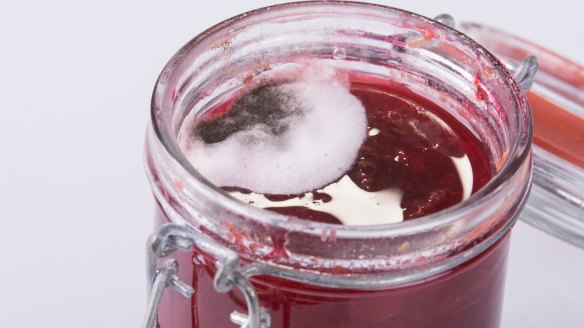Scrape off jam mould or throw out the jar? Food safety myths explained

British Prime Minister Theresa May has shocked the world by declaring she scrapes the mould off her jam.
In a recent cabinet meeting she reportedly passed on some tips on thrift and hygiene, telling fellow ministers that she would "not throw away a jar of jam if it has gone mouldy on top”.
So is Ms May talking sense?
Here's what the experts and food industry professionals have to say about eating mouldy jam, and food safety in general.
Is it safe to scrape mould off food?
The litmus test for mould is its colour. If the mould is pale blue or white, it's less harmful. But if it's black, green, yellow or orange, say goodbye.
"You have different types of mould, obviously some are more risky than others," said Dr Nick Fuller, from the University of Sydney's Charles Perkins Centre.
Those darker moulds produce toxins that can have adverse effects on humans, from gastro illnesses including vomiting and diarrhoea to, in some cases, death.
"It can get much worse if you have a weakened immune system."
Dr Fuller says vulnerable people, such as the elderly or pregnant women, should avoid mould-tainted food altogether, as eating it can cause damage to the immune system, worsening existing illnesses.
"Cutting it out is not safe enough," he said adding that removing even substantial areas around the mould may not eliminate the unseen toxins.
"It's no guarantee."
Leonie Mills, who's been a chef for 25 years and now teaches cookery at Geelong's Gordon School said attention should also be paid to the type of food. Where it might be OK to cut mould from dry aged beef, she "certainly wouldn't do it with chicken or pork."
Ms Mills said when it comes to cheese, firmer cheeses are less risky to cut mould off, whereas soft cheeses should be thrown out.
"The bacteria might be able to permeate a softer substance."
Dr Kim-Yen Phan-Thien, Senior Lecturer in Food Science at the University of Sydney said certain species of mould, such as Penicillium, are present in cheeses such as Gorgonzola to form its white outer skin or blue veins throughout. These moulds are safe to eat.
"There are so many species of fungi out there and many are not hazardous to humans," Dr Phan-Thien said.
Food items with a higher water content were more at risk of the bacteria spreading.
"Fluffy bread mould is less risky because once it's stale it's usually become hard," she said.
"Lower water activity is generally safer."
Is the three-second rule fact?
Dr Fuller said modern society has perhaps become "too fixated" on germs, bugs and bacteria.
He says you can probably pick food off the floor and eat it if it's been dropped for three seconds – or even longer – if you're confident that the floor is relatively clean.
"We don't need to be using disinfectant all the time and worrying about these types of things," he said, adding that germ exposure can be useful for growing children.
"If it's in your own home, depending on what it is, it will likely be fine."
What’s the difference between a best-before and a use-by date?
"Best before" is the food supplier’s recommendation of when the food is at its best, referring to food quality.
But Ronni Kahn, chief executive of food rescue charity OzHarvest believes it is "perfectly safe" to eat food after this date.
Dr Fuller advises consumers to apply the "smell test".
"If it's a dairy product, you can do the smell test to make sure it hasn't turned off. If it smells fine, you can have dairy products a few days after that date."
"Use by" is related to food safety and is the manufacturers' guide to when the product should be used by for food safety reasons. Dr Fuller said this date can act as a guarantee that food will be fine to eat up until that date but you will be putting yourself at risk once that date passes.
"Depending on what it is, you could be putting yourself at risk."
Should you always observe use-by dates?
Dr Phan-Thien said you should always abide by use-by dates.
"Because the judgement is on safety. If there is a use-by date, stick by it."
But when it comes to best before, it's up to the consumer to apply their best judgement.
"It might not make you sick, but it might not taste as good or perform as well in your cooking."
OzHarvest's Ms Kahn said food label confusion is a major source of food waste, adding that the US and UK are currently reviewing all food labelling to limit waste.
"Food labelling did not even exist when our grannies were around and they would not dream of throwing food away, so why should we?
"I’m sure Theresa May is just doing what her granny taught her."
"Food waste is already a huge problem and we should be doing everything in our power to avoid edible food ending up in the bin."
Restaurant reviews, news and the hottest openings served to your inbox.
Sign up